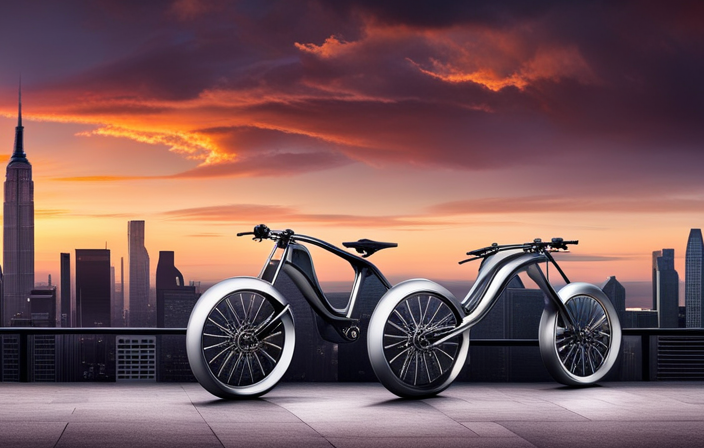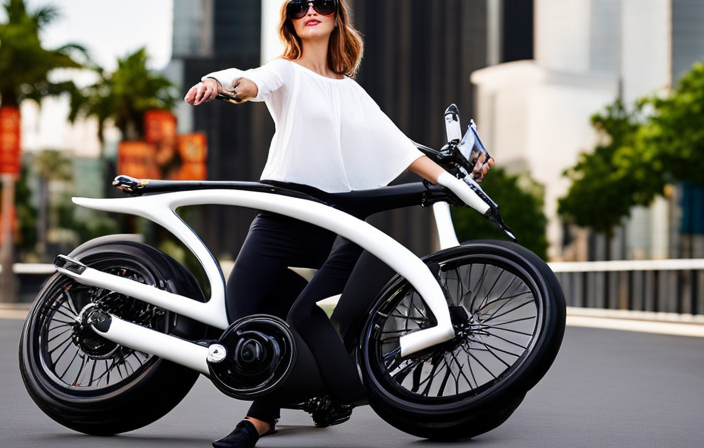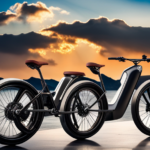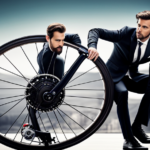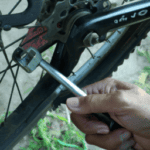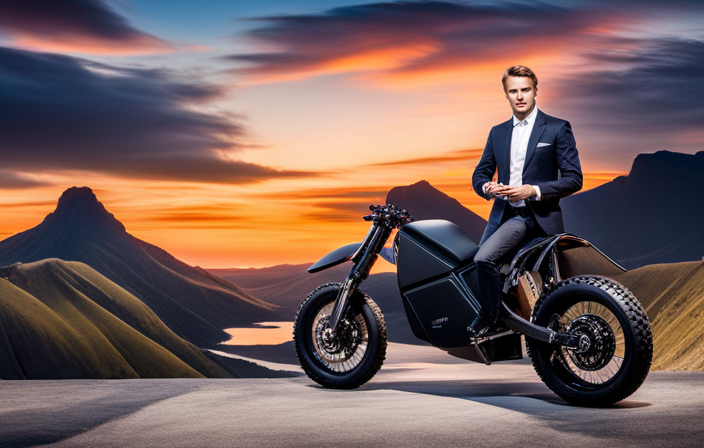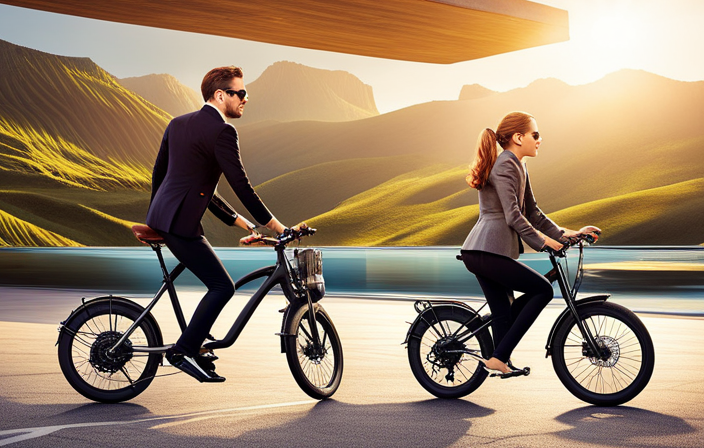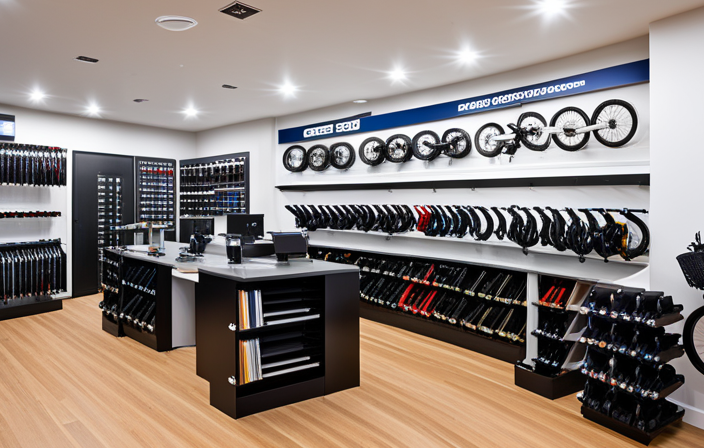According to the old adage, ‘Two wheels are better than four,’ and when it comes to electric bikes, the discussion about whether front or back wheel placement is better is a popular topic.
As an experienced rider, I’ve delved into the intricacies of both options and explored the pros and cons of each.
In this article, I’ll guide you through the factors to consider when choosing between a front or back wheel electric bike.
So buckle up, fellow cyclists, as we embark on this two-wheeled journey of discovery.
Key Takeaways
- Motor noise level is an important consideration when choosing between front wheel and back wheel motor for an electric bike.
- Motor power and torque play a crucial role in determining the performance of an e-bike.
- The placement of the battery is crucial for optimal performance, as it affects the balance and handling of the e-bike.
- Weight distribution and motor placement also impact the balance, stability, and handling of the electric bike.
Understanding the Difference between Front and Back Wheel Electric Bikes
If you’re looking to understand the difference between front and back wheel electric bikes, it’s important to consider their pros and cons.
When it comes to the motor placement, front wheel electric bikes have the motor located in the front wheel, while rear wheel electric bikes have the motor in the rear wheel.
One advantage of front wheel drive is that it provides better traction on slippery surfaces, as the weight of the motor helps to push the front wheel into the ground. This can be particularly useful when riding on wet or snowy roads. Additionally, front wheel drive offers a more natural riding experience, as it mimics the feel of a traditional bike.
However, there are also some drawbacks to front wheel electric bikes, which I will discuss in the next section about the pros and cons.
Pros and Cons of Front Wheel Electric Bikes
One advantage of front wheel electric bikes is their ease of installation. Unlike rear wheel electric bikes, which require more complex adjustments and modifications, front wheel electric bikes can be installed relatively easily. This is because the front wheel is typically designed to be compatible with electric motors, making the installation process straightforward.
When it comes to performance, front wheel electric bikes offer good traction and acceleration. The weight of the motor in the front helps with stability and allows for better control while riding. However, it is important to note that front wheel electric bikes may not perform as well in terms of handling and stability compared to rear wheel electric bikes. This is because the front wheel is responsible for both steering and propulsion, which can result in a less balanced ride.
Transitioning into the subsequent section about the pros and cons of back wheel electric bikes, it is important to consider both options to determine the best fit for individual preferences and riding conditions.
Pros and Cons of Back Wheel Electric Bikes
When considering back wheel electric bikes, it is important to weigh the advantages and disadvantages to determine the best option. Here are three key points to consider:
-
Improved traction: With the motor located in the back wheel, back wheel electric bikes provide better traction, especially in wet or slippery conditions. This can enhance your riding experience and increase safety.
-
Efficient power transfer: Back wheel electric bikes have a more direct power transfer from the motor to the rear wheel, resulting in a smoother and more efficient ride. This can lead to better overall performance and longer battery life.
-
Better weight distribution: By placing the motor in the back wheel, the weight is evenly distributed, improving stability and handling. This can be particularly beneficial when navigating challenging terrains or steep hills.
When comparing the performance of front and back wheel electric bikes, these factors highlight the advantages of back wheel models. However, before making a decision, it is important to consider your riding style and terrain.
Consider Your Riding Style and Terrain
To determine the most suitable option for you, consider your riding style and the type of terrain you will be navigating.
When it comes to electric bikes, both front wheel and back wheel options have their advantages and disadvantages.
If you prefer a more aggressive riding style and enjoy the feeling of being pulled forward, a front wheel electric bike may be the better choice for you. This setup provides better traction and stability, especially when climbing steep hills.
On the other hand, if you prioritize a smoother and more natural riding experience, a back wheel electric bike might be more suitable. It offers better weight distribution, making it easier to handle and maneuver. Additionally, a back wheel electric bike has a lower chance of skidding in wet conditions.
It is also worth considering the environmental impact of your choice. Front wheel electric bikes tend to have a slightly higher impact due to increased wear on the drive train.
Transitioning into the next section, assessing your skill level and comfort, it is important to take into account all these factors to make an informed decision.
Assess Your Skill Level and Comfort
Consider your own skill level and comfort when choosing the right electric bike for you. Evaluating your skill level is crucial to ensure that you can handle the power and speed of an electric bike. If you are a beginner, it might be wise to start with a bike that offers lower speeds and easier handling.
Assessing your comfort is equally important. Take into account factors such as the bike’s frame size, seat position, and handlebar height. A bike that fits you well will allow for a more comfortable and enjoyable ride. Additionally, consider your riding posture and whether you prefer an upright or a more aggressive position.
By evaluating your skill level and assessing your comfort, you can find the electric bike that best suits your needs.
Moving forward, let’s evaluate your commuting needs.
Evaluate Your Commuting Needs
Evaluate your daily commute and determine your requirements for an electric bike. Consider factors such as distance, terrain, and any specific needs you may have.
When it comes to electric bikes, two crucial aspects to consider are the bike weight and battery range. If you have a long commute or plan to ride uphill frequently, a lighter bike would be more suitable as it will require less effort to pedal. Additionally, battery range is important to ensure that you can complete your commute without running out of power. Assess the distance you need to cover and choose a bike with a battery range that meets your needs.
Taking these factors into account will help you choose the right electric bike for your daily commute.
Now let’s delve into the next section and take into account the type of bike frame.
Take into Account the Type of Bike Frame
When choosing an electric bike for your daily commute, keep in mind the type of bike frame that suits your needs. Bike frame compatibility is an important factor to consider when deciding whether to install the electric motor on the front wheel or the back.
Different bike frames have different designs and characteristics that can affect the overall performance and handling of the bike. For example, if you have a front suspension on your bike, it may be more suitable to install the motor on the back wheel to maintain balance and stability. On the other hand, if you have a rigid frame, installing the motor on the front wheel may be a better option.
Ultimately, the decision should be based on how the motor placement will impact the balance and stability of the bike. Keep this in mind as we transition into the next section and think about the motor power and torque.
Think about the Motor Power and Torque
Take a moment to think about how much power and torque you need from the motor on your electric bicycle. The motor power comparison is crucial in determining the performance of your e-bike. Here are some factors to consider:
-
Motor Power: Consider the wattage of the motor. Higher wattage means more power and better acceleration. It is important to match the motor power to your riding style and terrain.
-
Torque Analysis: Torque is the force that allows you to climb hills and accelerate quickly. A higher torque rating will provide better performance in challenging conditions.
-
Efficiency: Look for a motor that is efficient in converting power into motion. This ensures longer battery life and better overall performance.
-
Noise Level: Some motors can be quite loud, which may affect your riding experience. Consider the noise level of the motor when making your decision.
Considering the motor power and torque is essential, but don’t forget to also consider the battery placement and weight distribution for optimal performance.
Consider the Battery Placement and Weight Distribution
Consider where you place the battery on your e-bike and how the weight is distributed for optimal performance. The battery placement and weight distribution are crucial factors to consider when deciding between a front or back wheel motor for your electric bike. A well-placed battery can greatly improve the balance and handling of your bike, enhancing your overall riding experience.
To better understand the impact of battery placement and weight distribution, let’s take a look at the following table:
| Front Wheel Motor | Back Wheel Motor |
|---|---|
| Easier installation | Enhanced traction |
| Lighter front end | Better stability |
| Simplified wiring | Improved handling |
As you can see, the placement of the battery affects various aspects of your e-bike’s performance. Ultimately, it’s essential to seek expert advice and test ride both options to determine which setup suits your riding style and preferences. By doing so, you can make an informed decision and ensure an enjoyable and efficient electric biking experience.
Seek Expert Advice and Test Ride Both Options
It’s important to consult with experts and try out both options to determine the best setup for your e-bike. When considering whether to use a front or back wheel motor for your electric bike, seeking expert advice becomes crucial.
Experts can provide valuable insights and considerations based on their experience and knowledge. Additionally, conducting a test ride evaluation is highly recommended. By test riding both front and back wheel motor setups, you can assess their performance, handling, and overall feel.
This hands-on experience allows you to make an informed decision based on your personal preferences and riding style. Remember, expert opinions coupled with your own test ride evaluation will help you choose the optimal motor placement for your electric bike, ensuring an enjoyable and efficient riding experience.
Frequently Asked Questions
How does the weight distribution differ between front and back wheel electric bikes?
In terms of weight distribution, front wheel electric bikes tend to have a more balanced feel, with the weight evenly spread between the front and back. This balanced distribution positively impacts the bike’s handling and stability during turns and maneuvers.
What are some potential disadvantages of using a front wheel electric bike?
When considering a front wheel electric bike, potential safety concerns should be taken into account. One potential disadvantage is that the front wheel drive can affect the bike’s handling, especially during turns and on slippery surfaces.
How does the type of bike frame affect the performance of front and back wheel electric bikes?
The type of bike frame can significantly impact the performance of electric bikes. Factors such as weight distribution, stability, and handling are influenced by the frame design, ultimately affecting the overall performance of both front and back wheel electric bikes.
Can the motor power and torque of an electric bike affect its handling and stability?
The motor power and torque of an electric bike greatly impact its handling and stability. Higher power and torque provide better acceleration and climbing abilities. Front wheel electric bikes offer advantages like better traction and control, especially in wet or slippery conditions.
What factors should be considered when determining the placement and distribution of the battery in an electric bike?
When determining battery placement for an electric bike, it is crucial to consider weight distribution. By strategically placing the battery, you can optimize stability and handling, ensuring a smooth and balanced ride.
Conclusion
In conclusion, I would highly recommend taking the time to test ride both front and back wheel electric bikes before making a decision. It is crucial to assess your riding style, skill level, and comfort, as well as the type of bike frame, motor power, torque, battery placement, and weight distribution.
Seek expert advice to fully understand the nuances of each option. Remember, it’s important to find the perfect fit for your needs and preferences.
So, saddle up and let the wheels of your new electric bike take you on an exhilarating journey!
